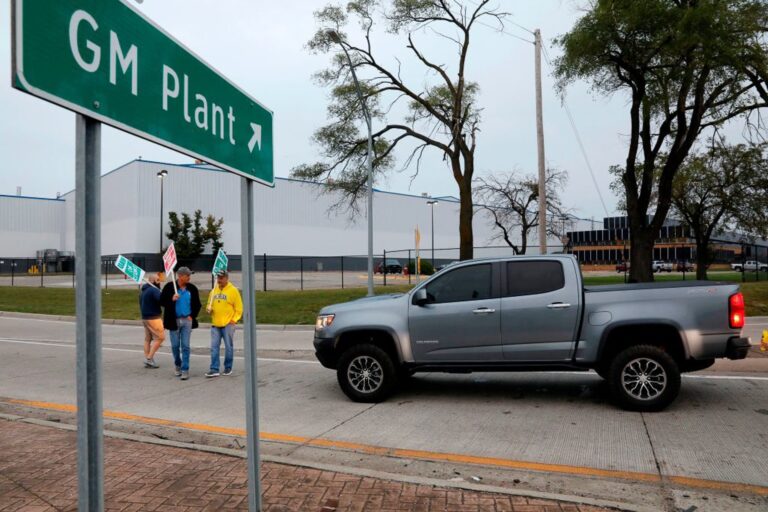
A strike that has affected America’s three biggest carmakers is entering its second week – and the acrimonious stand-off shows no sign of abating.
On one side is the United Auto Workers (UAW) union, which has 400,000 members across the United States.
It is seeking a 36 per cent wage rise for its members, as well as a 32-hour work week and a return to a retirement pension-plan model.
On the other side stands GM, Ford and Stellantis, America’s three largest carmakers.
The union is pitching its strike action – the first simultaneous strike against the companies in the union’s history – in the face of huge profits for the Big Three in the wake of COVID-19 pandemic-led supply issues.
“You deserve what you’ve earned, and you’ve earned a hell of a lot more than what you’re getting paid now.” – US President Joe Biden to Ford workers.
Stock shortages across the board have meant maximum profit margins for carmakers, despite fewer cars being sold.
Leading the union charge is its firebrand leader Shawn Fain, who theatrically hurled wage proposals from the car companies into his office garbage bin on video in the lead-up to the September 14 deadline.
The UAW represents 46,000 GM, 57,000 Ford and 43,000 Stellantis workers. Up to 19,000 employees across all three companies are now said to be on strike.
The union says it has a war chest of some A$1 billion, with striking workers receiving US$500 ($800) a week while off the job.
41 carmaker facilities affected
With a resolution still not reached, the union’s members have walked off the job at multiple facilities across America, including three manufacturing plants and 38 parts distribution centres.
The strike has the capacity to bring vehicle production – which was starting to normalise after a traumatic two years – to a grinding halt once again.
And the union appears to be in it for the long haul.
A series of leaked texts from the UAW’s communication head Jonah Furman to his boss suggests the union is ready for a protracted battle to get what it wants; vastly more pay and better conditions for its members.
“They can basically price in an all-out [strike]”, Furman texted to Fain. “But if we can keep them wounded for months, they don’t know what to do.
“Plus we’re breaking pattern and they’re bargaining against each other for the first time in 70 years.”
Furman dismissed the texts as “private messages”.
It has been estimated that the strike action could potentially cost each carmaker up to A$700 million each week if the action continues.
Presidential play
The strike has now become a political football, with President Joe Biden recently attending a UAW rally at a Ford facility.
He is the first US president to attend a picket line in modern history.
“You deserve what you’ve earned, and you’ve earned a hell of a lot more than what you’re getting paid now,” Biden said to the Ford workers.
Asked later whether workers deserved a 40 per cent pay rise, Biden said, “Yes. I think they should be able to bargain for that.”
Currently, the three automakers are offering pay increases in the order of 20 per cent.
Just hours before President Biden’s visit, a terse press release from Ford confirmed the company would halt work on a new battery factory in Michigan, a move interpreted by the UAW as a “barely veiled threat” on worker’s jobs.
Part of the stand-off is understood to be centred on matching pay and conditions for workers on EV assembly lines.
Meanwhile, former president Donald Trump appeared at a non-unionised parts maker in Michigan, declaring that electric vehicles would “spell the death of the US auto industry”, and railing against EVs that can “only drive 15 minutes before you have to get a charge”.
The former president, who is currently facing multiple charges including tax fraud, falsifying business records and tampering with classified documents, appeared to be addressing the Drake workers as though they were part of the strike, even though they were not.
Australian impact yet to be felt
While the factories and distribution centres affected by the strikes supply the US market, a potential tools-down at Ford’s Canadian engine plant in Ontario may restrict the flow of Coyote V8s that are destined for the engine bays of Mustangs.
Stellantis’s Toledo plant builds Wrangler and Gladiator models.
If the strike continues, parts supplies sourced from North America to suit Australian-delivered products may begin to dry up.
We recommend
-
 News
NewsGM strike impacts Corvette C8 and Acadia production
Holden set to be affected by the first major union action against General Motors in more than a decade
-
 News
NewsStellantis Australia appoints former Holden exec as new MD
Group now to be led by Michael Filazzola as current boss retires
-
 News
NewsFord to cut 3000 jobs in North America and India, follows Australian cuts
Ford says it is on track to have capacity for 600,000 EV sales by the end of 2023, but reports suggest it may need to cut a lot of jobs to get there



